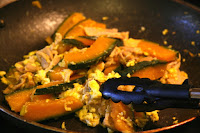I take a different approach and always make a point of going to a local food market when I go abroad. Even if I'm tight on time, it's fun to find some time and squeeze in going to a market to explore. It could be a supermarket, wet market or street market depends on the country, and these markets are filled with local food, which fascinates me all the time. "How do the local people cook this?" "Wish I could buy this in the States!" Many things come to my mind, and I never get tired of looking at food in a market.
When I stayed in Chiang Mai earlier this year, a beautiful walled city in the mountainous northern part of Thailand, needless to say, I enjoyed the exotic food every day. Wet markets, modern surpermarkets and street vendors became food paradise. Though I've been to Thailand before, many things felt new to me on this trip because Chiang Mai has a different food culture to the other parts of the country, such as Bangkok or the sea coast, due to the climate, culture and geography.
One day, I saw a huge pile of pumpkins sitting next to piles of fruits in a wet market. I wondered how people eat this pumpkin because I've never seen dishes with pumpkin in restaurants around my hotel. The pumpkin was faded green, dry and dusty looking, with a round shape, and was 2-3 times bigger than my home grown Kabocha. While walking back to my hotel and wondering about the pumpkin, I came across a street hawker lady who was selling cooked pumpkin in a plastic bag. The pumpkin was cut into 3" pieces and there was dark color liquid on the bottom part of the bag. "Oh, I see! She's selling Kabocha Nimono (one of the most common Japanese pumpkin dishes in Japan) to Japanese tourists! Or maybe the locals buy this as Japanese food is the most trendy foreign food here these days...such things crossed in my mind.
I was brave and tried it and found out that the pumpkin was surprisingly sweet as it is cooked with sugar, and the locals eat it with coconut's milk. Nothing like what I experienced in Japan. I wouldn't have guessed this pumpkin and coconut combination and was surprised how pumpkin could be such a simple sweet.
Today's recipe is another unexpected combination which I encountered during this trip: pumpkin and egg. Pad Fuktong Sai Kai, which means stir fried pumpkin with egg in Thai, is a typical street hawker food. This quick cooking, casual dish overturned my preconceptions about using pumpkin. People tend to think Thai food is always spicy or coconuty, but it's not. Pad Fuktong Sai Kai tastes mild and you can enjoy the simple flavor, which goes well with a seasoned accompaning dish. As I have one unmature Kabocha which is more like Thai pumpkin here, I will use it as a substitute. I'm hoping you enjoy this dish with a little of imagination of crowded steet food venders in Thailand.
Pad Fuktong Sai Kai, Kabocha with Egg Recipe
INGREDIENTS
- 7oz Kabocha (1/8 small size Kabocha)
- 3oz Pork back ribs (thin sliced, boneless)
- 1 egg (beaten)
- 1 garlic clove (finely minced)
- 1/2 cup water
- 1/2tbsp Nam pla (fish sauce)
- 1/2tbsp sugar
- 1/2tbsp vegetable oil
Serves 2
★If Kabocha is too hard to slice, microwave the Kabocha until soft.
2. Cut the pork into 1 inch long strips. If you can not buy thin sliced pork, freeze pork rib, then half defrost and slice the meat thin. The picture below is the half-defrosted meat.
3. Heat the oil in a frying pan. Add the garlic and pork, and cook slightly. Add the Kabocha, water, sugar and Nam Pla. Cover with a lid and cook over a medium low heat until the Kabocha is cooked. Remove the lid.
4. Cook over a medium high heat until the water disappears. Add the beaten egg and gently mix together. Cook over high heat until the egg is cooked.




























